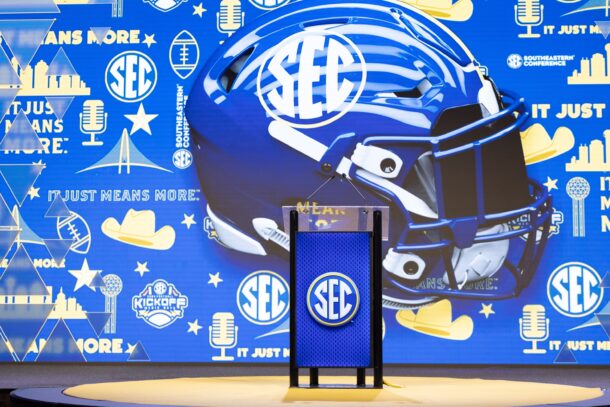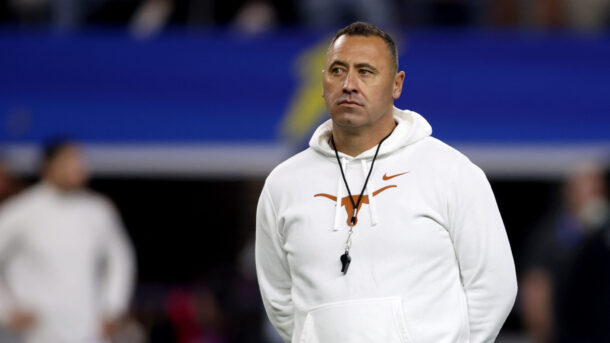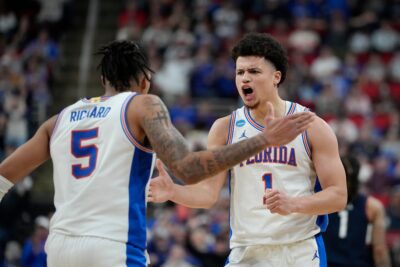Ad Disclosure

Punt returners like Texas A&M’s Christian Kirk a dying breed in today’s SEC
By John Crist
Published:
Because we spend so much time focusing on offense and defense, it’s awfully easy to forget that a third of the game is played on special teams.
In particular, the art of the punt return seems to be at an all-time low. I can’t ever recall a time when so many return men are making catastrophic mistakes, costing their offenses field position and committing terrible turnovers.
Returners continue to field longer punts inside the 10-yard line, instead of just taking their chances on a touchback at the 20. They aren’t aggressive enough fielding the shorter punts and watch helplessly as the ball bounces further back into their own territory. Not to mention that lunatic trying to secure one off a bounce in a crowd of tacklers, oftentimes leading to a fumble.
Are punt returners not as effective as they used to be, or are coverage units doing a better job taking this special skill away?
In 2015, there were 18 punt-return touchdowns in the SEC. Alabama’s Cyrus Jones had four all by himself, while Texas A&M’s Christian Kirk, Tennessee’s Cameron Sutton, Florida’s Antonio Callaway and Georgia’s Isaiah McKenzie recorded two each.
By 2016, that figure had dropped to 12. Kirk had three, plus Alabama’s Eddie Jackson delivered a pair. But so far in 2017, about two-thirds of the way through the schedule, we have seen only four punt-return TDs. LSU’s D.J. Chark has two of them. One was given to Mississippi State’s Jeffery Simmons after he recovered a block in the end zone.
Two years ago, seven different players averaged double-digit yards on punt returns. This year, there are only three.
“Punters are hanging it up a little bit more with hang time because you’re able to cover the field, and really you’ve got six to seven guys that are your old-school gunner-type guys that are free to the ball,” Missouri coach Barry Odom said Wednesday on the league’s weekly coaches teleconference. “That causes a lot of different issues on the punt-return team.”
The Tigers are fourth in the conference with an average of 12.3 yards per return, while the Aggies are third at 12.6.
“I think it’s a combination of schematics with what people are doing to cover the punts and directional kicking,” Texas A&M coach Kevin Sumlin said. “The punting has become more specialized. Rugby style. Short, high kicks. It’s no longer just who can punt the ball the furthest.”
Both Odom and Sumlin have had success returning punts throughout their time in Columbia and College Station, respectively. The Tigers are fourth in the conference with an average of 12.3 yards per return, while the Aggies are third at 12.6.
“We’ve worked on, specifically this season, trying without a doubt to field the football,” Odom said. “Number one, secure the football for our offense. And then, if we can get a first down. So we want to get 10 yards. Now that’s hard to do. If you’ve got guys that are rolling out, you’ve got the opportunity to be able to place the ball.”
“Now the punting has become so specialized, with guys that actually utilize sky kicks in the middle of the field,” Sumlin said. “Where maybe the change of possession may only be 38 yards, but it’s a net 38. Where you’re punting it 52 yards, but you’re giving the guy cushion and it’s the danger of giving up a touchdown.”

For Mizzou, Richaud Floyd (above) still doesn’t have enough attempts to qualify for the SEC lead, but he averages 15.6 yards per return and had an 85-yard score against Idaho. For A&M, Kirk also doesn’t have enough returns to be among the leaders but averages 13.8. He’s been forced to call for a ton of fair catches due to his reputation.
“The art of catching a punt and returning it, you better spend a whole bunch of time on it,” Odom said. “Because it’s a lot more difficult than the flight of the ball, and especially when you get rolled out and how they’re driving the football now at times. Some guys are driving it, trying to almost out-kick the coverage.”
“You’re aware of what the returner can do, and the style of punt has varied across the league. Particularly in our league, with free releases and gunners and things like that. But I think, more than anything else, it’s been different styles of punting that have really made it difficult to set up a return.” — Kevin Sumlin
“He’s played enough football,” Sumlin said of Kirk. “It’s like anything else. I think what you’ve seen is, when he’s had his opportunities, when they have punted it to him deep, he’s still been able to be effective in the return game.”
Believe it or not, but Kirk only has 33 punt returns to his credit in his career. Incredibly, he’s scored a touchdown on five of them.
“There’s a whole bunch of things that go into it,” Odom said. “As far as what is deemed as a good punt returner for us, we want to focus on catching the football. And if we get into a return situation, we want to get a first down for our offense.”
“You’re aware of what the returner can do, and the style of punt has varied across the league,” Sumlin said. “Particularly in our league, with free releases and gunners and things like that. But I think, more than anything else, it’s been different styles of punting that have really made it difficult to set up a return.”
No question about it, punters are more powerful than ever. Four of them in the conference average 45 yards or more per punt, led by Florida’s Johnny Townsend at 49.5. As recently as 2013, Tennessee’s Michael Palardy was the league leader at 44.5.
In addition to unadulterated leg strength, punters also have more tricks up their (leg) sleeve. Like Odom and Sumlin mentioned, there are high-and-short punts. There are deep-and-directional punts. There are rugby-style punts. Punt formations from special teams coaches are also more intricate and get tacklers in a return man’s face faster.
While it may be a buzzkill when Kirk signals for another fair catch, as the expression goes, discretion is the better part of valor.
“They can cross kick,” Odom said. “They can roll out. They can do all the different things now with the way that our rules allow it to happen. That’s probably caused more demise for the punt-return team than anything else.”
“When you have a player like (Kirk), there’s other things you can do,” Sumlin said. “That’s probably why we’ve blocked punts the last three games.”
John Crist is an award-winning contributor to Saturday Down South.




